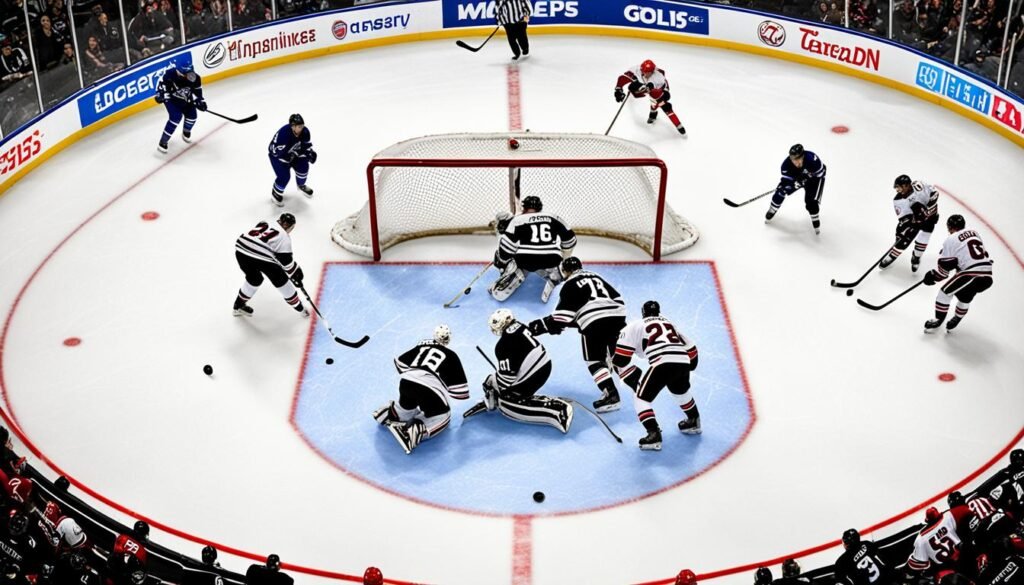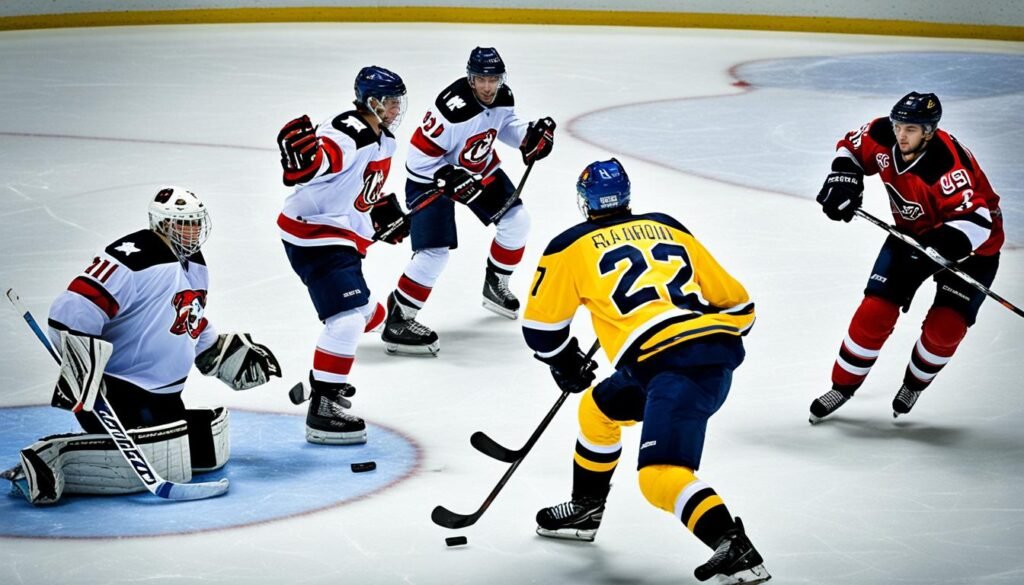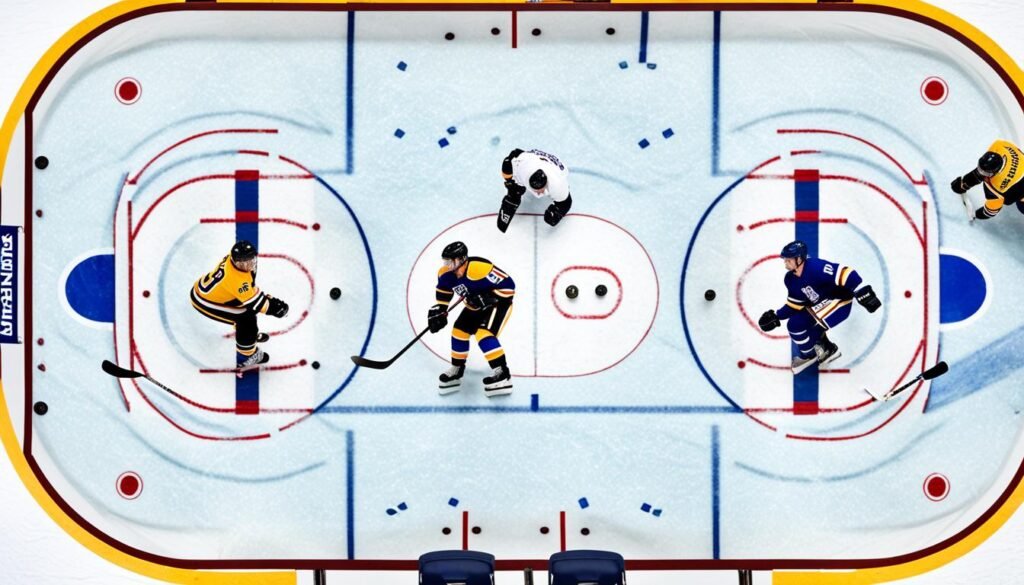Are you curious about how many players on a hockey team are? Whether you’re a hockey fan or a player yourself, understanding the player count and lineup in hockey is essential. In this quick guide, I’ll provide you with all the information you need to know about the number of players on a hockey team, the roster size, and the various game situations that can affect player numbers on the ice.
In hockey, each team consists of six players on the ice: three forwards, two defensemen, and one goaltender. This makes a total of twelve players between both teams during normal play. Additionally, each team typically has four lines, totaling twenty players, including the goaltender. Players are usually on the ice for only one minute at a time before being substituted on the fly. Each game consists of three periods, with a total of sixty minutes of ice time.
Key Takeaways:
- A hockey team is made up of six players on the ice: three forwards, two defensemen, and one goaltender.
- Teams usually have four lines, totaling twenty players, including the goaltender.
- Players are typically on the ice for only one minute at a time before being substituted.
- Each game consists of three periods, with a total of sixty minutes of ice time.
- Understanding the player count and lineup in hockey is important for both fans and players.
Now that you have a better understanding of the player count on a hockey team, let’s dive deeper into the team roster and lineup.
Hockey Team Roster and Lineup
When it comes to a hockey team’s roster and lineup, there are key considerations for coaches and fans alike. Let’s dive into the details of how a hockey team is composed and the players in a hockey lineup.
Each NHL team is allowed to have a roster of 23 players, but only 20 of those players can dress for each game. This means that there are three players who are part of the team but do not participate in the game. Having a deep roster allows teams to have depth and flexibility, ensuring they are prepared for any situation.
The lineup, which consists of the players who are on the ice during a game, typically includes 12 forwards, 6 defensemen, and 2 goalies. This distribution of players ensures a balance between offensive firepower and defensive stability. The forwards are responsible for generating scoring opportunities, the defensemen focus on preventing goals, and the goalies guard the net.
In hockey, there are unlimited substitutions allowed, meaning that coaches can make changes to their lineup as necessary. Each line, composed of three forwards and two defensemen, typically plays together for around 45-90 seconds before a line change occurs. This constant rotation of players keeps the team fresh and maximizes their performance on the ice.
Here is a breakdown of the typical hockey team lineup:
| Position | Number of Players |
|---|---|
| Forwards | 12 |
| Defensemen | 6 |
| Goalies | 2 |
Understanding the hockey team roster and lineup is crucial for coaches to optimize their strategies and for fans to appreciate the different roles and contributions of each player on the ice.
Now that we have explored the hockey team roster and lineup, let’s move on to the various game situations and player numbers in section 3.
Game Situations and How Many Players on a Hockey Team
In ice hockey, the number of players on the ice can vary depending on the game situation. Let’s take a closer look at the different scenarios and the corresponding player numbers involved.
In Normal Play
During regular gameplay, without penalties or overtimes, each team has a total of six players on the ice. This includes three forwards, two defensemen, and one goalie. The goalie’s primary responsibility is to defend the net and prevent the opposing team from scoring.
Penalties and Skater Reduction
When a team commits a penalty, the penalized team will have fewer skaters on the ice. The exact number of skaters depends on the severity of the penalty. In some cases, the penalized team will have only three skaters remaining, while in other cases, they may have four skaters.
Overtime Play
During overtime, each team skates with three players and one goalie. Overtime play occurs when the game is tied at the end of regulation time and requires additional time to determine a winner. The reduced number of players on the ice creates more open space and often leads to faster-paced and exciting gameplay.


Penalties and Power Plays in Hockey
Penalties in hockey can have a significant impact on the game, resulting in temporary player removal and creating power play opportunities for the opposing team. Let’s take a closer look at how penalties and power plays work in hockey.
Penalties and Player Numbers
When a player commits a rule violation, they are typically sent to the penalty box for a specific duration defined by the type of penalty. The penalty durations can range from a minor penalty of 2 minutes to major penalties of 5 minutes or more. In severe cases, a player may even receive a game misconduct penalty, leading to their ejection from the game.
During a penalty, the team of the penalized player must play with one less skater on the ice, resulting in a disadvantage known as being “shorthanded.” The exact number of players a shorthanded team has depends on the situation. For minor penalties, the penalized team plays with four skaters plus a goalie, while for major penalties, they play with three skaters plus a goalie.
On the other hand, the team that benefits from the penalty plays with a numerical advantage known as a power play. During a power play, the team has one extra skater on the ice, giving them more opportunities to score goals. The power play team typically consists of five skaters plus a goalie.
Now, let’s visualize the player numbers during a penalty and power play situation in a table:
| Team | Skaters | Goalie | Total |
|---|---|---|---|
| Shorthanded Team | 4 | 1 | 5 |
| Power Play Team | 5 | 1 | 6 |
Understanding Power Plays
Power plays are a crucial opportunity for teams to capitalize on their numerical advantage and increase their chances of scoring goals. The shorthanded team’s defense must work harder to prevent the power play team from taking advantage of the extra skater.
During a power play, teams often employ specific strategies and formations to create scoring opportunities. The extra skater allows for more puck movement, passing options, and offensive plays. It’s common to see power play units setting up in formations such as the “umbrella” or “diamond” to create shooting lanes and open up passing lanes.
Overall, penalties and power plays play a significant role in the dynamics of a hockey game, often shifting momentum and providing exciting scoring opportunities. Understanding the player numbers and strategies involved in these situations can enhance your understanding and enjoyment of the game.


Conclusion
A hockey team typically consists of 20 players. During a game, there are 6 players on the ice at a time, including 3 forwards, 2 defensemen, and 1 goalie. These athletes work together to outscore the opposing team and secure victory for their own team.
Off the ice, a hockey team can have up to 23 players on its roster. However, only 20 players are dressed for each game, meaning they are eligible to participate in that particular match. This ensures that there are always enough players available to maintain a competitive edge.
It’s important to note that game situations can result in different player numbers on the ice. For example, when a team is penalized, they will have fewer skaters on the ice, whereas during overtime, each team will skate with only 3 players and 1 goalie. These variations in player count introduce unique strategies and challenges that add excitement to the game.
Understanding the player count and lineup in hockey is essential for fans and players alike. Whether you’re cheering on your favorite team or stepping onto the ice yourself, knowing the player count and positions will enhance your appreciation and involvement in the game.

